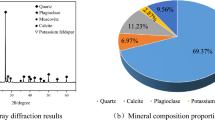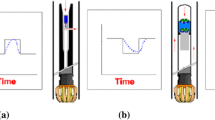Abstract
The success of waterjet drilling technology requires further insight into the rock failure mechanisms under waterjet impingement. By combining acoustic emission (AE) sensing and underwater sound recording techniques, an online system for monitoring submerged waterjet drilling has been developed. For four types of sedimentary rocks, their AE characteristics and correlations to the drilling performance have been obtained through time–frequency spectrum analysis. The area under the power spectrum density curve has been used as the indicator of AE energy. The results show that AE signals from the fluid dynamics and the rock failure are in different ranges of signal frequency. The main frequencies of the rock failure are within the higher range of 100–200 kHz, while the frequencies of the fluid dynamics are below 50 kHz. Further, there is a linear relationship between the AE energy and the drilling depth irrespective of rock type. The slope of the linear relationship is proportional to the rock strength and debris size. Furthermore, the AE-specific energy is a good indicator of the critical depth drilled by the waterjet. In conclusion, the AE characteristics on the power density and dominant frequency are capable of identifying the waterjet drilling performance on the rock materials and are correlated with the rock properties, i.e., rock strength and cutting size.












Similar content being viewed by others
References
Agus M, Bortolussi A, Ciccu R, Kim W, and Manca P. (1993) The influence of rock properties on waterjet performance. In: Paper presented at the Proceedings of the 7th American water jet conference, Seattle, Washington, USA
Axinte D, Kong M (2009) An integrated monitoring method to supervise waterjet machining. CIRP Ann Manuf Technol 58(1):303–306
Aydin G, Karakurt I, Aydiner K (2013) Prediction of the cut depth of granitic rocks machined by abrasive waterjet (AWJ). Rock Mech Rock Eng 46(5):1223–1235. doi:10.1007/s00603-012-0307-1
Crow SC (1974) The effect of porosity on hydraulic rock cutting. Int J Rock Mech Min Sci Geomech Abstr 11(3):103–105. doi:10.1016/0148-9062(74)91539-3
Dehkhoda S, Hood M (2013) An experimental study of surface and sub-surface damage in pulsed water-jet breakage of rocks. Int J Rock Mech Min Sci 63:138–147. doi:10.1016/j.ijrmms.2013.08.013
Fu J, Li G, Shi H, Niu J, Huang Z (2012) A novel tool to improve the rate of penetration–hydraulic-pulsed cavitating-jet generator. SPE Drill Complet 27(03):355–362
Harris HD, Mellor M (1974) Cutting rock with water jets. Int J Rock Mech Min Sci Geomech Abstr 11(9):343–358. doi:10.1016/0148-9062(74)93098-8
Hassan AI, Chen C, Kovacevic R (2004) On-line monitoring of depth of cut in AWJ cutting. Int J Mach Tools Manuf 44(6):595–605
Hood M (1985) Waterjet-assisted rock cutting systems—the present state of the art. [journal article]. Int J Min Eng 3(2):91–111. doi:10.1007/bf00881623
Hood M, Nordlund R, Thimons E (1990) A study of rock erosion using high-pressure water jets. Int J Rock Mech Min Sci Geomech Abstr 27(2):77–86
Kovacevic R, Kwak H, Mohan R (1998) Acoustic emission sensing as a tool for understanding the mechanisms of abrasive water jet drilling of difficult-to-machine materials. Proc Inst Mech Eng Part B J Eng Manuf 212(1):45–58
Kovacevic R, Momber A, Mohen R (2002) Energy dissipation control in hydro-abrasive machining using quantitative acoustic emission. Int J Adv Manuf Technol 20(6):397–406
Li G, Huang Z, Tian S, and Shen Z (2009) Research and application of water jet technology in well completion and stimulation in China. In: Paper presented at the 9th Pacific Rim International Conference on Water Jetting Technology, Fukushima Japan
Liu X, Liu S, Ji H (2015) Numerical research on rock breaking performance of water jet based on SPH. Powder Technol 286:181–192
Liu Y, Wei J, Ren T (2016) Analysis of the stress wave effect during rock breakage by pulsating jets. Rock Mech Rock Eng 49(2):503–514
Lu Y, Huang F, Liu X, Ao X (2015) On the failure pattern of sandstone impacted by high-velocity water jet. Int J Impact Eng 76:67–74
Mohan R, Momber A, and Kovacevic R (1994) On-line monitoring of depth of AWJ penetration using acoustic emission technique (pp. 649–664): Mechanical Engineering Publications Ltd., London, England
Momber A (2000) Concrete failure due to air-water jet impingement. J Mater Sci 35(11):2785–2789. doi:10.1023/a:1004782716707
Momber A, Kovacevic R (1998) Principles of abrasive water jet machining. Springer, Berlin
Momber A, Mohan R, Kovacevic R (1999) On-line analysis of hydro-abrasive erosion of pre-cracked materials by acoustic emission. Theor Appl Fract Mech 31(1):1–17
Momber A, Mohan R, Kovacevic R (2002) Fracture range detection in hydro-abrasive erosion of concrete. Wear 253(11):1156–1164
Oh T-M, Cho G-C (2016) Rock cutting depth model based on kinetic energy of abrasive waterjet. Rock Mech Rock Eng 49(3):1059–1072. doi:10.1007/s00603-015-0778-y
Rabani A, Marinescu I, Axinte D (2012) Acoustic emission energy transfer rate: a method for monitoring abrasive waterjet milling. Int J Mach Tools Manuf 61:80–89
Raghu Prasad BK, Vidya Sagar R (2008) Relationship between AE energy and fracture energy of plain concrete beams: experimental study. J Mater Civ Eng 20(3):212–220. doi:10.1061/(asce)0899-1561(2008)20:3(212)
Welch PD (1967) The use of fast Fourier transform for the estimation of power spectra: a method based on time averaging over short, modified periodograms. IEEE Trans Audio Electroacoust 15(2):70–73
Zeng J, Kim TJ (1996) An erosion model of polycrystalline ceramics in abrasive waterjet cutting. Wear 193(2):207–217. doi:10.1016/0043-1648(95)06721-3
Acknowledgements
We would like to thank the KMT Company for sponsoring the Advanced Waterjet Cutting System for educational and academic use in university. We would also like to gratefully acknowledge the comments by the anonymous reviewers, which have helped to improve the manuscript. This work was financially supported by the National Natural Science Foundation of China (No. 51490652) and Science Foundation of China University of Petroleum, Beijing (No. 2462014YJRC048).
Author information
Authors and Affiliations
Corresponding author
Rights and permissions
About this article
Cite this article
Tian, S., Sheng, M., Li, Z. et al. Acoustic Emission Characteristics of Sedimentary Rocks Under High-Velocity Waterjet Impingement. Rock Mech Rock Eng 50, 2785–2794 (2017). https://doi.org/10.1007/s00603-017-1252-9
Received:
Accepted:
Published:
Issue Date:
DOI: https://doi.org/10.1007/s00603-017-1252-9




